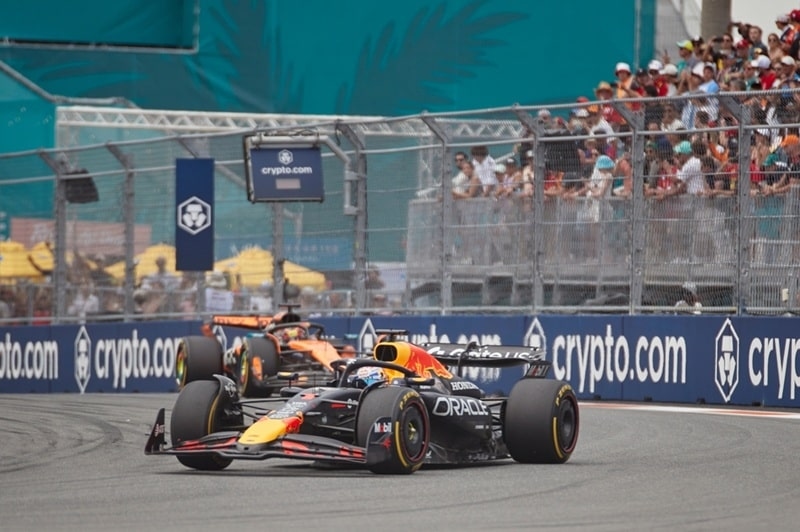Unveiling The Role Of VR In F1 Driver Preparation Today

Video games related to automobiles pose a stimulating form of entertainment for the majority, yet within the realm of F1 racing, simulators transcend mere amusement to become indispensable business tools. In the high-stakes world of Formula 1, each team meticulously hones their race cars and nurtures skilled simulator drivers, who tirelessly clock thousands of laps within sophisticated simulation setups preceding every Grand Prix event in the packed F1 calendar.
For F1 drivers, simulators serve as a crucial arena to refine their craft and anticipate the performance of their vehicles under varying track conditions and anticipated weather scenarios on race day. Meanwhile, F1 development squads harness the power of simulators and virtual reality to innovate and assess novel car designs and components, meticulously analyzing the repercussions of any alterations within the intricate framework of F1's regulations.
F1 Racing Simulators

Beyond mere steering wheels and pedals outfitting a home-based racing simulation setup can entail an investment of several thousand dollars, encompassing elements such as a racing seat, cockpit console with steering apparatus, shifters, pedals, and multiple displays arranged for immersive viewing, the realm of professional-grade simulators transcends these consumer-grade offerings. Priced in the range of an entry-level BMW and beyond, individuals can acquire racing simulators constructed upon FIA-licensed suspension platforms, delivering authentic sensations of G-forces as they navigate virtual tracks. With the inclusion of customizable features like a bespoke seat tailored to the user's physique, the cost can rival that of a new base model Porsche 911.
In contrast, the simulators utilized by F1 teams represent multimillion-dollar investments, featuring dedicated workstations for teams of simulation performance engineers. These F1 race car simulators are meticulously crafted mock-ups of cockpit environments, complete with replicated front wing structures, ensuring an experience mirroring that of the actual race car. Every control, display, and sensory aspect must mirror its real-world counterpart with utmost precision.
You may also like to read: Lando Norris Gets First Taste Of F1 Las Vegas Circuit
F1 Race Preparation and Simulator Practice
Within the facilities of F1 teams, simulators are interconnected via computer systems, enabling simulation performance engineers to fine-tune race car configurations for testing their performance under various track and weather conditions. Teams leverage updated lidar scans of tracks to enable both simulation drivers and race car drivers to familiarize themselves with the circuit and explore different racing lines comprehensively, a task impractical within the constraints of tightly regulated practice sessions on real tracks, when the tickets have been sold already.
Prior to Grand Prix events, race drivers from each team typically undergo simulator sessions fully kitted out in racing gear, including fire-resistant layers, helmets, and steering apparatus. In contrast, professional simulator drivers tasked with evaluating vehicle setups and the impact of track and weather conditions on car performance are less likely to don full racing attire and equipment. In addition to pre-race simulations, simulation drivers conduct tests during practice and qualifying sessions of the Grand Prix and even during the actual race itself, aiming to gain deeper insights into the cars' behavior, address queries, or evaluate potential adjustments. Following races, simulation drivers may continue running laps to replicate the actions of team race car drivers on the track, enabling engineers to scrutinize the performance of the vehicle and discern underlying reasons for its performance outcomes.
Utilizing Virtual Reality in F1 Practice to Uphold Regulations

Image Source: News For Speed
Formula 1 teams employ racing simulators for purposes beyond mere driver training and practice. In the fiercely competitive domain of motorsport, victory margins in F1 races often hinge on minuscule fractions of second, compelling racing outfits to invest substantially in their pursuit of competitiveness. Given that F1 is regarded as the pinnacle of motorsport, unbridled spending in the quest for race victories poses a genuine threat to the integrity of the sport. This looming threat underscores the necessity for the multitude of rules and regulations governing F1, meticulously crafted to safeguard the sport's essence.
Administered by the Federation Internationale de l'Automobile (FIA), the regulatory body for various forms of automotive racing, including F1, these regulations serve to foster competition, equity, and safety. The FIA issues annual editions of F1 regulations encompassing sporting, technical, and financial aspects, delineating allowable specifications for most components of F1 race cars to ensure parity among competitors. Moreover, these regulations mandate precise performance evaluation and analysis across numerous facets, including driver capabilities, vehicle components, adjustments, and specific racetrack characteristics. For the 2023 season, FIA-imposed financial regulations in F1 include a stringent cost cap of $138.6 million, covering the majority of team operational expenses for the year, albeit with certain exceptions such as engine development costs.
Racing Simulators are Indispensable Tools
While the establishment of F1 racing simulators incurs considerable expenses, they serve as indispensable tools, sparing teams from the exorbitant costs associated with conducting real-life tests using actual cars and drivers in additional facilities. Leveraging F1 simulators, powerhouse teams like Redbull F1 and Mercedes F1 can meticulously test components, refine driver skills, and devise race-day strategies aimed at capitalizing on the razor-thin margins separating finishing positions in F1 races. The integration of virtual reality and authentic driver simulators has become ubiquitous across all F1 teams, underscoring their pivotal role in modern racing endeavors. They give an experience similar to walking near the tracks.
Conclusion
Virtual reality (VR) has revolutionized F1 driver preparation, transcending traditional methods and ushering in a new era of immersive training. By simulating realistic racing scenarios, VR enables drivers to hone their skills, familiarize themselves with tracks, and fine-tune race strategies in a cost-effective and efficient manner. Moreover, VR technology plays a crucial role in upholding F1 regulations, and ensuring fairness and safety in the sport. As F1 teams continue to leverage VR simulations for driver training and development, we can expect further advancements in performance and competitiveness, ultimately enhancing the thrilling spectacle of Formula 1 racing for fans worldwide.
This content was created by AI




